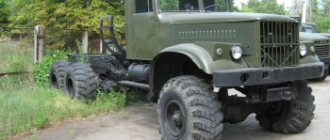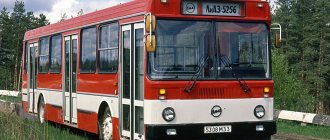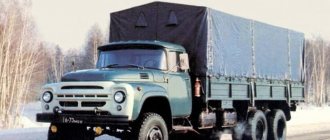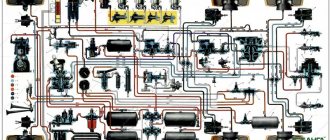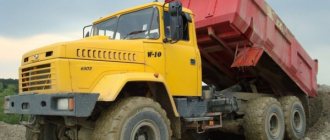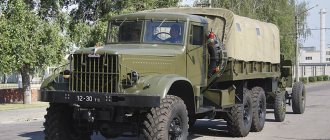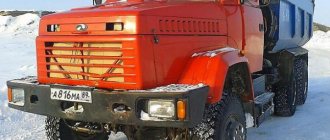KrAZ-255 without residues
Sergey Trufanov, photo by Igor Denisovets
Models of Kremenchug all-terrain vehicles, which went on sale at the end of 2014, became a bright and discussed debut of a new family, the main release of which will take place in 2015.
I would like to say right away: the views expressed in the article will not be entirely familiar to some. And there are two significant reasons for this. Firstly, I have been a consultant for many years and, accordingly, I am guessing on the topic “why exactly did the manufacturer do this?” I’m not at a loss, since I initially participated in the creation of the models and knew the true reasons. Moreover, the activity of a consultant implies the authorship or co-authorship of many of the decisions made. Secondly, being a stand modeler who relatively recently became interested in 1:43 scale cars from the “Auto Legend” series, I retained my “wrong” approach from the point of view of some collectors.
Purpose
KRAZ 255 is a classic all-terrain vehicle for the most difficult road conditions. The vehicle has a variety of both civilian and military specialties. In the national economy, the car was used in logging, in the geological exploration industry, in production and various types of construction, in agriculture and aviation support.
In the military field, a truck is used to transport people with equipment, transport various weapons, and engineering equipment and military systems for various purposes are installed on the chassis (from anti-aircraft guns to electronic warfare systems). Over a long period of time, the car was purchased by Latin American countries, China, Pakistan, India and almost the entire “socialist camp,” which speaks volumes about its high performance in almost any weather and climatic conditions.
About a riot of colors
There was not much variety in the choice of color for the models; cars of this type were mostly military, so by definition, green shades became dominant. The army wisdom “it’s good when everything is ugly, but uniform” does not apply to models, so we had to do our best to diversify the colors with different shades of green. The KrAZ trucks that have survived to this day, 20 years after the end of production, including army vehicles, have already been tinted and repainted several times, so along with the factory khaki, other shades, seen in the photographs, were also made.
The KrAZ-255B also received a sand-beige color (this color scheme was used not only on military vehicles supplied to Asia and Africa), it was also found on KrAZ vehicles transferred for use in the national economy of the southern republics of the USSR. In addition, for each modification, one color option was provided from the Autoexport catalogs of the 1970s, which will please fans of bright, but at the same time authentic car colors. And although exhibition copies are rare, for me personally the KrAZ-255B1 with a light orange cab and a dark red-orange body is canonical in its own way.
A worthy heir to traditions
The need to modernize the KrAZ-214B model, which was quite successful for its time, but outdated in a number of technical parameters, arose in the mid-60s, and by 1967 Kremenchug automakers mastered the serial production of a new model of an all-wheel drive three-axle heavy truck. At the same time, the design of the truck has undergone significant changes.
KrAZ-214B from the plant museum
Externally, the new KrAZ was not much different from its predecessor. Perhaps only the new wide-profile tires indicated that the truck belonged to a new modification. It was thanks to the tires that the truck received its nickname “laptezhnik”, which took root among all those who operated this vehicle.
But the design of the truck itself has undergone major changes. And, first of all, this is a replacement of the power unit. The six-cylinder two-stroke diesel engine was replaced by a more powerful and economical V-shaped four-stroke eight-cylinder power unit YaMZ-238.
YaMZ-238
Let's compare some technical characteristics of the old and new modifications. The maximum speed increased from 55 km/h to 70 km/h, while fuel consumption decreased from 120 to 70 liters per 100 kilometers. Half a ton more than the previous model, with approximately the same curb weight.
However, VI-3 tires differed not only in their tread pattern and width. For the first time in the history of KrAZ trucks, the vehicle was equipped with a centralized tire pressure regulation system, which was controlled from the driver’s workplace. For example, when driving in deep snow or quicksand, the driver could reduce the tire pressure in just a few minutes from 3.8 to 1.0 atmospheres.
At the same time, the tire pressure on the supporting surface increased by 70%. As a result, the pressure of the wheels on the ground decreased, helping to increase the truck's maneuverability. This is the principle of operation of the centralized tire pressure control system. In 1979, the twelfth year of serial production, a more efficient dual-circuit braking system began to be installed on the 255th.
About the models of yesterday and today
This is not the first KrAZ-255 model in 1:43 scale. Quite a long time ago, the Cimmeria workshop released a small series. About six years ago, an industrial model of Saratov-Ukrainian origin came out. Another KrAZ-255 model is announced in the plans of SSM/AIST. Thus, the two existing models could not satisfy everyone who wanted to receive the long-awaited “swamp” model into the collection.
According to the design specifications, the model range included not only the “255th” models, but also the KrAZ-214 that preceded them and the new KrAZ-260 family that replaced the KrAZ-255 on the assembly line. The unification of families and the budget niche of models implied some compromises that had to be made deliberately. In particular, the KrAZ-255B model received double air receivers and their location from the KrAZ-255B1, since there was no longer room on the molding frames for casting individual parts, and the PF-10 marker lights on the “255B” wings had to be made together with the wing. However, the overall level of “victims of unification” is noticeably lower in comparison with previous NAP developments.
Budget restrictions did not allow the use of transparent parts in all optics, which in the case of the KrAZ is less critical, since this family of optics in general is not as developed in comparison with later cars of the 1980s and 1990s, which had large and bright lights , parking lights and direction indicators.
Truck modifications
The KRAZ 255 can confidently be ranked one of the first places in terms of versatility. The main modifications of the civilian versions include:
- KRAZ-255B - produced since 1967 as an airborne platform and chassis. In addition to transporting goods and transporting people in the tilt platform version, the chassis was intended for the installation of truck cranes, excavator devices, drills, hydraulic manipulators, pile driving machines and other equipment;
- KRAZ-255BS - produced since 1969. Modification adapted for operation in conditions of ultra-low temperatures in northern regions;
- KRAZ-255B1 – production began in 1979. Unlike previous modifications, it was equipped with a dual-circuit pneumatic brake drive with antifreeze protection;
- KRAZ-255V is a truck tractor equipped with a fifth-wheel coupling device. The design is designed to tow a semi-trailer weighing up to 18 on country and dirt roads, and 26 tons on paved roads and highways;
- KRAZ-255L is a timber tractor-trailer produced since 1969. The trailer was connected to the vehicle using a special towing mechanism that transmitted traction force and weighted the vehicle with part of the cargo being transported.
Among the military modifications are:
- AC-8.5-255B – tank truck for transportation, short-term storage, and refueling of various types of equipment with light petroleum products;
- EOV-4421 – hydraulic excavator for carrying out engineering support work for troops with a bucket capacity of 0.65 cubic meters;
- PMP – pontoon-bridge park for equipping bridge crossings of various carrying capacity;
- MBPC is a mobile bath and laundry complex. Since 2015, it has been used in the Armed Forces to organize bathing procedures in the field;
KRAZY 255s have long been used as aircraft tractors both at civilian airports and at military airfields and are excellent at towing 100-strong aircraft.
In addition to the main model of the KrAZ-255, there are several other types of Laptezhnik, which are practically no different from each other, but still have a number of additional characteristics. Let's look at them in a little more detail:
- The first truck produced at the Kremenchug plant was named KRAZ-255b. This is a standard all-terrain vehicle with a platform and chassis. Most often, the car was used as a towing unit and transporting medium loads.
- The updated model of the KrAZ 255b1 truck was introduced in 1979 and had a separate brake drive.
- The next version of the all-terrain vehicle was designed to move semi-trailers weighing up to twenty-six tons. It is worth noting that such a high figure was allowed only on paved roads, and as for off-road, on average it was possible to tow a load of up to eighteen tons.
- The KrAZ 225L was equipped with a special trailer and was used as a timber carrier.
The KrAZ-255 can move unhindered through swampy areas.
Most of the vehicles produced on the territory of the Soviet plant were the KRAZ 255 B1 series during the period when production volumes were 7-8 thousand vehicles per year. It is important to note that in addition to modifying the all-terrain vehicle for the civilian sector, several types of Laptezhnik were produced for military purposes. In fact, the main characteristics of the machine did not change in any way, and additional extensions were installed using specially designed add-ons. For example, a fuel tanker or even heavy mechanized bridges.
Drawing of Kraz 255 – Telegraph
Drawing KRAZ 255
Download file - Drawing KRAZ 255
Topic of the Trial and Trophy section in the Car Models category; So I decided to post a photo of my project. Kraz is also called a laptezhnik. I decided to make it from galvanized steel. Drawings found helped a. Forum Help Community Forum options All sections read Navigation NNTP Contacts Groups Diaries What's new? Forum Car models Trial and Trophy Kraz B made of iron. Shown from 1 to 40 of Kraz B made of iron Topic of the Trial and Trophy section in the Car Models category; So I decided to post a photo of my project. Kraz is also called a laptezhnik. Topic Options Printable Version Email… Subscribe to this topic…. The bridges will be from the axial and gearbox. I plan to frame the frame from a polyethylene aluminum profile. The chassis will be 6x6. Who knows how best to paint galvanized steel, please tell me. It is painted like ordinary metal, but if you wish, you can easily sand it. Victor and when we see Kamaz. It's good to keep it that way! Please tell us in more detail. GALOSHA gasoline-solvent purified nefras - with Soldered the loaf, just washed everything with cold water, everything was washed off successfully. No matter how much time has passed, nothing rusts. I can't think of any hinges for the hood. Have you weighed the box yet? In order for the tie rods to run parallel, the servo must be placed horizontally. The office there only orders large quantities. I bought a copper tube at the auto market, inserted an electrode with a thread into it, the rod turned out to be rigid and was difficult to bend. I had to disassemble the Land Rover for now. Yur needs tubes, write the sizes, I’ll buy them and send them. It seems we have it. I also have no problems with a long pin and proper tightening. I think that everything here very much depends on the correspondence to the scale. What is the scale of the KRAZ you have, somewhere around 1: In this case, it’s a little more than 70 cm, which can be shortened a little for the trial, but again, depending on what will be on this frame: Then you probably won’t be able to shorten the frame much, but you can use the trick that suggested and used in this post by teammate Serujio, who by shortening the body increased the angle of the rear overhang. I see the hinges are moving a little tight, the hood is stuck in a half-closed state. Overall, very, very good! Similar topics GAUI cool kid has grown up again! I will sell 2 GAUI Hurricane helicopters from Tigron in Moscow in the Flea Market section. Electric motors, speed controllers, accessories. Your rights You cannot create new topics You cannot reply to topics You cannot attach attachments You cannot edit your messages BB codes On.
Wheels and tires KrAZ-255
Hello, guest Login Registration. Help Search Users Calendar File archive. Search this forum only? KrAZ and its drawing are a problem. I'm making this beauty, but there's a problem with the drawing. But, only in one place. So the whole drawing is basically satisfactory. Yes, something doesn’t quite fit along the lines, etc. Still, the drawing itself is normal. But, in one place, and I’ll notice not only in this drawing, but also in his other drawings, although all the rest are complete bullshit, but there can’t be such a discrepancy. Okay, a couple of cm, but not the whole bumper. For the life of me, it doesn’t fit together at all. Where is the beginning of the wing and bumper. There are examples in the archive. I haven't been able to figure out why for several days now. You begin to adjust according to the drawing. The parts fit into each other. If you try to move everything apart a little, the shape disappears. If anyone has a little time, please try it. Maybe it will work for someone. What I know is that the drawings almost never match. And as soon as I didn’t, etc. But only in this place it was plugged. Although the drawing itself is normal. And when editing, everything is as it should be. But there’s a problem with this place, damn it. I hope that I missed something somewhere and therefore it doesn’t add up. Well, did it add up for anyone? I already wrote that it coincides. When you draw parallel lines between different types, elements, etc. So, everything fits together wonderfully. I probably checked it a dozen times. But there’s just an incomprehensible problem here. Panton has nothing to do with it. Measured by the cabin and its elements. Home Help Search Users Calendar File archive Gallery Search only in this forum? Pion View profile ipsmenu. Nako View profile ipsmenu. So what's next? Do everything except this detail, then model it from the photos and adjust it.
Description of the KrAZ-255 model (255 B1, 255 V1)
Housing Code of the Russian Federation Article 36
How to make an optimus mask
KrAZ-255 frame
Religion in Israel
Home textiles website
Kraz 255 B made of iron
Moskovsky 129 on the map
Find the value of the expression 4 11 4 9
telegra.ph
Expansion of the model range
From the very beginning of serial production, the KrAZ-255B was positioned as the base model, on the basis of which a family of trucks for various purposes began to be formed.
The first of its “brothers” was the KrAZ-255V truck tractor, which was intended for towing semi-trailers weighing up to 26 tons with a maximum load on the saddle of 8 tons. In the civilian version, the tractor was mainly used as a trailer version transporting tracked construction equipment. A significant number of tractors were supplied to units of the Soviet Army, where they were used to tow semi-trailers with special equipment and rocket and artillery weapons.
truck tractor KrAZ-255V
The third vehicle in the 255 family was the industrial timber carrier KrAZ-255L, the production of which was mastered by factory workers in 1969. The timber carrier became the only all-wheel drive truck produced at the Kremenchug Automobile Plant, intended only for the needs of the country's national economic complex. Complete with a TMZ-803 trailer-trailer produced by the Tavdinsky Machine-Building Plant, the timber tractor-trailer was intended to transport up to 40 cubic meters of round timber. The unloaded trailer could be transported on a tractor platform.
In the same 1969, an interesting modification of the KrAZ-255BS appeared in the northern version. This machine was not mass-produced, but one of its curious elements soon appeared on all production Laptezhniks. The mentioned element is special extensions on the front fenders in which the headlights were installed.
Today it is almost impossible to imagine KrAZ without these very “birdhouses”, and hardly anyone now remembers the first versions of the 60s without this simple element. Thus, the northern version, which never went into production, contributed to the appearance of this characteristic “calling card” on all KrAZ trucks produced in the 70s and 80s.
Later, next to the “birdhouses” on the front wings of all-terrain vehicles, special dimensional indicators appeared in the form of a spring pin with a plastic spherical tip. This element is called a “mustache” among drivers. Dimensional pins helped the driver maneuver. After the 255 family began to be equipped with two wide rectangular rear-view mirrors, the classic, familiar image of the Kremenchug “Laptezhnik” was finally formed.
About prototypes
A description of the history of the creation, production and service of the KrAZ-255 in the army and the national economy deserves a monograph that exceeds several journals in volume at once. (see “Laptozhniki” without bast shoes” and “Forest Handsome Man”) The famous “Bolotniki” or “Lapotniki/ Laptezhniki” became truly popular all-terrain vehicles. Another attempt to embody the image of KrAZ trucks in the form of scale replica models is another facet of the fame of the famous prototype. And since the KrAZ-255 does not need additional glorification, I will only briefly mention two modifications released. One model represents the KrAZ-255B produced in 1967–1969, the first modification of the Kremenchug all-terrain vehicle family with a four-stroke YaMZ-238 diesel engine and early optics, separate headlights and side lights mounted on the wings. Since 1969, a new arrangement of front lighting equipment appeared in box-shaped casings on the wings; the model was also called KrAZ-255B, but in appearance it became noticeably different. Another model is the KrAZ-255B1, a modernized version that received a dual-circuit brake system; it was produced from 1979 to 1994.
Suspension and chassis
The front suspension of the MAZ 255 is on two semi-elliptical springs with two double-acting telescopic hydraulic shock absorbers. The ends of the springs are installed in rubber pads of the support bearings. The rear suspension is balanced, on two semi-elliptic springs with sliding ends. Equipped with six reaction rods.
The steering mechanism is a screw and a ball nut-rack engaged with a gear sector with a hydraulic booster. Working pressure up to 70 kgf/cm2. The service brake system is equipped with drum mechanisms. Drive – pneumatic, double (circuit 1 – front and middle axle, circuit 2 – rear axle). The parking brake is transmission, drum type.
The mechanism is installed on the output shaft of the transfer case. The role of a spare brake is performed by a working circuit of the working system. Auxiliary brake – motor retarder. The trailer brake drive is combined (one- or two-wire). The brake system is equipped with a moisture separator with thermodynamic cleaning of compressed air and an alcohol fuse against condensate freezing.
The car is equipped with two tanks, each of which holds 165 liters of diesel fuel. The range is approximately 750 km on two full tanks.
Fuel consumption is approximately 30-40 liters for every 100 km. To turn around, KrAZ will need 14.5 meters of free space.
The permissible engine roll allows you to overcome climbs with a fairly large slope - up to 58o, and with a full load (it is 7,500 kg). If necessary, the KrAZ-255 can easily overcome small fords with a depth of no more than 1 m.
The KrAZ-255 is equipped with various additional equipment that makes operation easier and adds functionality to the vehicle:
- fifth wheel;
- winch;
- engine preheating;
- tire pressure regulation system.
The car is quite large, so the displacement of the refueling tanks is quite large. They should be filled in the following quantities:
- 51 liters of antifreeze or antifreeze into the cooling system;
- 32 liters of engine oil is necessary for high-quality engine lubrication during operation;
- 3.9 l – for normal operation of the hydraulic booster;
- 16 liters of oil are required to lubricate the transfer case;
- 1.25 liters of oil is poured into the steering housing;
- each axle must be filled with 12 liters of special gear oil;
- Each shock absorber will need 0.75 liters for normal operation.
Despite the truck's year of development and the use of outdated systems in its design, it is still in use. There are many reasons for this.
At the combat post
Despite the fact that Laptezhnik has become widely used in various sectors of the national economy, it is no secret that it was created, first of all, for the needs of the country's armed forces.
It is noteworthy that combat complexes and weapons systems were not installed on the KrAZ chassis, however, it became the base vehicle for army engineering services. Each of the modifications of special engineering vehicles built on the basis of the KrAZ-255B is unique and deserves a detailed description. Most of them are successfully used today.
Kraz-255 PMP at work
The Soviet-made pontoon crossing system was in service not only with the Warsaw Pact member countries, but also with some capitalist countries. For example, the PMP on the KrAZ chassis is still in service with the Finnish army.
The heavy mechanized bridge TMM and the combined arms mobile excavator EOV-4421, which is operated not only by engineering units of the armies of the CIS countries, but also by the UN peacekeeping contingent, turned out to be technically perfect.
A lot of special equipment based on the KrAZ-255 has been created for airfield support units. These are various modifications of fuel tankers, unique airfield installations for monitoring the hydraulic systems of heavy transport aircraft, fire hydrants, and towing vehicles.
The air defense forces are well known for the radar rangefinders installed on the Laptezhnik chassis; KrAZ trucks were also used as transport-loading vehicles for missile systems. In the Strategic Missile Forces, KrAZ-225V truck tractors were used to tow semi-trailers with missile systems.
In the armed forces of the allied states of the USSR, combat complexes were created on the basis of the 255th. Thus, in Angola, surrogate armored personnel carriers were built on the KrAZ-225B chassis; in Cuba, the truck was adapted for a self-propelled artillery mount with an armored cab. In the North Korean armed forces, after lengthening the truck frame, the S-125 Pechora air defense system launch complex was installed on its chassis.
Transmission
The tractor-trailer is equipped with a mechanical five-speed transmission YaMZ-236N. Gears 2, 3, 4, and 5 are synchronized. Torque is transmitted from the engine through a double-disc friction dry clutch with a mechanical drive. The transfer case is two-stage, equipped with a locking center differential for the middle and rear axles.
The KrAZ-255 uses a standard model as a clutch, which is used on all vehicles with similar overall dimensions and operating specifications. It has the following technical characteristics and properties:
- clutch type – friction;
- two disks engage;
- the design uses cylindrical springs;
- The discs themselves operate without lubrication, there is no oil bath.
Since the KrAZ engine was developed quite a long time ago, it does not provide for the installation of an automatic transmission. That is why the truck is equipped only with a manual transmission. It has the following design features:
- fixed shaft axes are used;
- there are gears that are in constant mesh (excluding first gear and reverse gears);
- the box is three-way;
- number of gears – five;
- There are synchronizers that compensate for the lack of a divider (used in KamAZ) and work in second-third and fourth-fifth gears.
The transfer case has the following features and technical specifications:
- type – mechanical;
- includes power take-off shaft (for winch);
- There are two stages and a center differential.
The cardan transmission consists of several main parts:
- open type shafts;
- intermediate supports;
- cardan shafts.
The KrAZ is equipped with three drive axles, and it is thanks to them that it is famous throughout the world for its amazing maneuverability.
The design of the front axle has some features: it contains CV joints (additional constant velocity joints). They are responsible for transmitting torque to the front wheels during turning.
Attention! On the middle axle there is a special platform intended for mounting the rear axle driveshaft support.
The front and rear suspensions have different designs and technical characteristics:
- the front one rests on two semi-elliptical springs, which are equipped with a pair of shock absorbers (hydraulic, working in both directions);
- The rear suspension is mounted on two semi-elliptical longitudinal springs (equipped with three pairs of reaction bars).
The brake system is standard, it differs only in its rather large weight.
It includes the following elements:
- brake pads;
- brake drums;
- pneumatic drive and vacuum booster;
- additional brake motor (decelerates).
The braking distance of a car at various weights:
- at a speed of 40 km/h – 17 m;
- at a speed of 40 km/h with a trailer – 18.5 m.
Manual
The operating instructions contain the following recommendations:
- It is allowed to start driving only after the diesel engine has warmed up to a temperature of 40-50°C. Long-term operation of a motor with a temperature below 75°C under load is not allowed.
- The pressure in the lubrication system should not fall below 1 kgf/cm² at idle speed.
- When the all-terrain vehicle is coasting, it is prohibited to engage neutral gear in the transfer gearbox.
- When towing a vehicle, the speed should not exceed 20 km/h, the transfer case lever should be in neutral position.
- When operating the machine in the cold season, the oil cooler should be disconnected from the lubrication system.
- It is prohibited to operate a truck with a faulty hydraulic power steering.
- It is not allowed to engage the front axle and activate the center differential lock when the wheels are slipping and when driving on paved roads.
- After stopping the engine, disconnect the batteries from the on-board network using the standard switch.
- The use of the engine brake is allowed for a short time and only when the gear is engaged.
Laptezhnik in deserts and tropics
The foreign career of our “Laptezhnik” deserves a separate discussion. It was thanks to the interest shown in the truck by foreign customers that the Laptezhnik, unlike most Soviet trucks of that time, received a fairly wide range of colors.
At first, all serial Kremenchug trucks were painted in a protective color. However, after the All-Union Association “Avtoexport” managed to promote the new product of the Soviet automobile industry to the markets of Africa and Asia, the “Laptezhnik” in export version, at the request of customers, began to be painted in sand color.
Over the years of production, KrAZ trucks were exported to 50 countries around the world. They appeared on the roads of all continents, excluding Australia and Antarctica. Among other advantages, the truck stands out for its durability. Even after many years after the cessation of production, they can today be found not only in our country, but also where they were exported many years ago.
In Europe, most of them are in Poland and Germany. After the transition to NATO standards, the armed forces of the former socialist countries began to decommission Soviet equipment. Most of the cars ended up in the hands of private operators. In Poland, on the basis of former military KrAZ vehicles, tow trucks for vehicles were built, and in Germany, many fan trucks appeared that transport tourists in mountainous areas, participate in various auto shows, and some examples even become flagship cars in wedding processions.
Numbers against the backdrop of a glorious history
The first all-terrain vehicle of this series was produced in 1967 at an automobile plant in Kremenchug, Ukraine. Thanks to the original 6/6 wheel formula and some other details, the car received the nickname “bast shoe” or “bast shoe”. The development of the new truck is based on its predecessor, the KrAZ-214, from which the 255 inherited its compact dimensions and basic functions.
The need to create a new all-terrain vehicle arose in the early 60s, since earlier models were very outdated and in many ways inferior to Western technology. Trying to maintain a monopoly over the market and modernize their own production, Soviet engineers began developing an improved model of the car.
The last model of the truck was released in 1993.
Visually, the KrAZ-225 was no different from the older versions, and the first noticeable updates to the design occurred only in 1969. The main innovation was the front lighting technology and the movement of turn signals into special boxes made of metal. Soon the heavy truck gained popularity not only in the republic, but also in all countries of the USSR. The car became the calling card of the Kremenchug plant and the best modified equipment of the 70-80s.
The main purpose of an all-terrain vehicle is to transport medium-heavy cargo on any roads, regardless of their condition. The Laptezhnik underwent many special endurance tests until the engineers were completely convinced that it was capable of covering long distances in bad weather conditions and off-road conditions.
The last truck of this brand was produced in 1993 after the collapse of the Soviet Union. Due to the economic crisis and lack of government funding, the plant in Kremenchug gradually lost its attractiveness, and the truck began to be inferior to other similar models due to a lack of modernization.
Over the years of production, the Kremenchug Automobile Plant supplied about 82 thousand KrAZ-225 trucks of various modifications and versions to the Armed Forces of the USSR and allied countries. Record deliveries were recorded in 1981, when KrAZ manufactured and delivered 5,591 vehicles to the USSR Armed Forces and for export.
In total, over the entire period of production, 197,155 trucks of this family rolled off the assembly line of the Kremenchug Automobile Plant. After the collapse of the Soviet Union, the truck was produced for about two more years, however, in 1993 it was discontinued, giving way to more modern and economical models of off-road trucks .
KRAZ-255 at the British military show
The KrAZ-225B family is one of the most successful projects not only of Kremenchug automakers, but also of the entire Soviet automobile industry. It is thanks to this that “Laptezhnik” rightfully became the symbol and personification of the Kremenchug brand.
Operational parameters and features of the KrAZ-255 engine
Almost throughout the entire period of mass production, the appearance of the KRAZ 255 did not change. The angular, three-seater wood-metal cabin with the most simplified instrument panel suited both manufacturers and consumers for decades. The improvements mostly concerned the suspension and chassis parts.
In 1979, a separate brake drive appeared on the KRAZ 225B1. In 1985, the balancer axles and springs underwent technical improvements. A few more technical improvements were made, but overall the car was not significantly modernized. On some modifications, a drum-type winch with a worm gear was installed, developing a traction force of 8 to 12 t.p.
An engine with excellent performance values called YaMZ-238 is used as a power plant in the car. Year of development - 1950, it was designed at the Yaroslavl Motor Plant.
The most common diesel is used as fuel. Moreover, its quality is not important: in the working chamber, both ECTO class fuel and old Soviet diesel fuel will burn equally well.
We invite you to consider the advantages
cultivators Viking 685
and other previous models.
From the following article you will learn the technical characteristics of KamAZ-53215.
YaMZ-238 has the following design features:
- the modern version is equipped with turbocharging (previously this option was not installed);
- the engine can be equipped with 6 or 8 cylinders;
- number of working cycles – 4;
- a mechanical injection pump is used as a power supply system;
- the cylinder block is made of cast iron;
- the running engine is cooled using liquid;
- all cylinders are located in relation to each other at an angle of 90 degrees in a V-shape;
- bottom mechanism type – OHV with overhead valves;
- distance from bottom to top dead center – 140 mm.
Since the most common mechanical fuel injection pump is used as the power supply system for the combustion chambers, each cylinder is equipped with its own pumping station. All of them carry out direct injection.
It is due to this that such a large torque is achieved - 1,765 N×m. The power of the YaMZ-238 engine (its basic version) is 177 kW or 240 hp. With.
The intake lines are located directly in the camber of the cylinder block. The OHV is located next to the crankshaft. It is driven by a pair of gears that are mounted in the front of the engine housing.
The number of valves is a pair for each working cylinder.
The designers paid special attention to the connecting rod racks: they are located at an angle of 90 degrees in relation to the crankshaft. This is what allows for fully synchronized flashes, which makes the engine operate very smoothly and quietly.
The cylinder liners themselves are made of high-strength cast iron, thanks to this the engine life is increased many times, which allows major repairs to be carried out only once per 800 thousand km.
The crankshaft is made of high-strength steel by hot stamping. Even and odd-numbered crank mechanisms are located relative to each other at an angle of 180 degrees (while being in the same plane).
More recently, KrAZ trucks were produced with new, modified engines based on YaMZ-238. Their design allows them to comply with EURO-3 environmental standards.
Further modification to meet higher environmental standards is practically impossible, according to the developers. Nevertheless, this power plant continues to be used in almost all KrAZ models.
The maximum speed developed by the truck is 71 km/h. Up to 60 km/h acceleration time is 40 seconds.
Kraz bast tires sizes
All-terrain vehicles Taiga pinned post
Low pressure tires used in the production of Taiga 4x4 all-terrain vehicles.
We get asked a lot of questions about the wheels on which our all-terrain vehicle is assembled. Obodryshi tires are made from a large number of car tires. Let's talk about tires below. We don't use everything.
Also, group visitors ask a lot of questions about various components of the all-terrain vehicle. Let's try to answer everything gradually.
So. The main tires from which rims are made. OI-25. Ural. Size 14.00-20 or 370-508. Layering norm is 10/12/14/16. The rubber is double-bundled, but sometimes single-bundled rubber is also found. Average weight 94 kg. Outer diameter 1260.
IP-184. Ural, KAMAZ. Size 1220*400-533. Ply rate is 10. Double-bundle rubber. Average weight 90 kg. Outer diameter 1200.
VI-3 Kraz. Ural, KAMAZ. Size 1300×530-533 (530/70-21). Layering norm is 12/14/16. Double bundle rubber. Average weight 140 kg. Outer diameter 1280.
ID-P 284. Ural. Size 1200×500-508 (500/70-20). Ply rate is 16. Double-bundle rubber. Average weight 116 kg. Outer diameter 1185.
VID-201 Kraz. Ural, KAMAZ. Size 1300×530-533 (530/70-21). Analogous to VI-3. Ply rate is 16. Double-bundle rubber. Average weight 140 kg. Outer diameter 1280.
O-47A. In common parlance "Natasha". Ural, KAMAZ. Size 1100×400-533 (400/70-21). Ply rate is 12. Double bundle rubber. Average weight 107 kg. Outer diameter 1120.
Tires are cut by hand. The main pattern is a herringbone. The picture shows an option with and without a central stripe. Here, as they say, who likes what. Some users like it without a central stripe, explaining that it has better cross-country ability. In our opinion, cut lugs hold stronger with the central stripe, although the lug wheels turn out to be several kilograms heavier.
At the buyer's request, we can cut a non-serial design, for example, a gear tread. After stripping, the weight of the wheel is reduced by more than half.
We make rims for low-pressure tires with our own hands. As a standard, we make discs for tubeless. We cut blanks for the disk with a laser, bend the cones ourselves, and weld them ourselves. The bedlocks are ours too. We paint in a spray booth with powder. After assembling the wheel, we add a special liquid to the inner cavity to seal it. For this purpose, the tap is made with a large cross-section. There is an adapter for inflating the wheel. In general, in caracat engineering there are disks without cones, simply cylindrical, but we abandoned this design.
Which wheels are better? The simpler the better. Ural OI-25 or IP-184 are enough.
But for meticulous pilots, you can dig deeper. Several indicators need to be considered together.
Everything here is simple and there are few indicators. This is the wheel volume, width and height.
I'll try to explain with numbers. In terms of theoretical dimensions, if you just take the volume of one tire, the picture comes out like this:
But this is not the entire volume of the wheel. The conical disc adds its two cents to the volume of the wheel.
Total wheel plus disk we have:
The total volume of the wheel affects buoyancy; an all-terrain vehicle with a large wheel volume will have less “draft” in the water. Here is the leader of VI-3 (or VID-201).
Even if we take into account that the wetted volume does not exceed half the volume of the wheel, the difference is very large. VI-3 differs from OI-25 in the sum of 4 wheels by more than 200 liters. Indeed, all-terrain vehicles on the VI-3 swim well. It would even be more correct to say that they have a smaller draft.
Wheel height affects ground clearance. The largest ground clearance is for OI-25 and VI-3. On the other hand, the slightly smaller wheel diameter of the IP-184 and IDP-284 gives better driving dynamics. The all-terrain vehicle is more torquey and responsive to gas.
The width of the wheel affects the contact patch. IDP-284 and VI-3 are good here. That is, it should be better for a liquid swamp.
What's bad? Or rather uncomfortable. The all-terrain vehicle on VI-3 has a large width. Not convenient in the forest, does not fit into the Gazelle. Well, VI-3 is more expensive than all the others.
Engine
Most of the 255 KRAZ vehicles produced are equipped with a YaMZ-238M2 engine.
- Type – four-stroke, compression ignition;
- Number and arrangement of cylinders – 8, V-shaped;
- Working volume – 14.86 l;
- Power at a crankshaft speed of 2100 rpm – 240 hp. (176kW);
- Maximum torque at a crankshaft speed of 1250-1450 rpm – 883 Nm (90 kgf.m);
- The minimum specific fuel consumption is 214 g/kW.
The engine is equipped with a PZD-44MBU pre-heater.
Price in Russia
Since the car model was discontinued more than twenty years ago, unfortunately, it is impossible to purchase a new KrAZ-255. But at the same time, thanks to high demand in the USSR, many trucks have been preserved in good condition today. If you wish, you can always choose a high-quality all-terrain vehicle in good condition for about 600-700 thousand.
So, concluding the article, it is worth emphasizing once again that even such “oldies” as the KrAZ-255, which has long been out of production, can be useful in your daily work and perform tasks of any complexity. Of course, if you compare the parameters of the truck with other modern brands, it will seem very outdated, but at the same time, the price of a Soviet car is much more attractive than the cost of its Western counterparts.
If you find an error, please highlight a piece of text and press Ctrl Enter.
Since the MAZ 255 car is no longer produced, you can only purchase a used car. The price for 15-20 year old cars starts from 300 thousand rubles. There are copies removed from storage. The price of such machines after re-opening can reach up to 2 million 500 thousand rubles.
